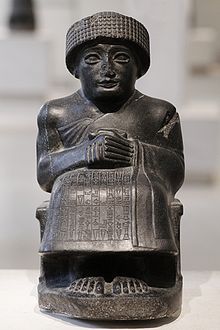Mesopotamian dreamwork
Turning to western sources, one of the oldest recorded dream accounts comes from around 2200 B.C., namely that of a dream of a Sumerian king named Gudea. Gudea reigned in the city of Lagash at that time and had a dream in connection with a temple he proposed to build (Van de Castle, 1994, p. 49). Another ancient dream account is encountered in the renowned Assyrian Gilgamesh epic (the standard version was compiled by Sin-liqe-unninni sometime between 1300 and 1000 BC out of older legends) (Wolff, 1952, pp. 100 - 108 & Boa, 1988, pp. 67 - 71) and recorded on incised clay tablets which were discovered in 1849 in an extensive ancient library in Nineveh (Oppenheim, 1956).
Based on his studies of ancient Near Eastern texts, Dr. A. Oppenheim, professor of Assyriology at the University of Chicago's Oriental Institute, proposed a scheme for classifying dreams found there into a) message dreams, in which usually a king was visited in a dream and given some sort of advisory by a deity or some representative thereof; b) mantic dreams, in which people looked for omens as to what the future would bring; and c) symbolic dreams, which were usually feared since they were said to presage disease or encounters with demonic powers (Oppenheim, 1966).
Van de Castle also reported something interesting about Near Eastern dream practices:
"We might sometimes share our dreams with a family member or a friend in an attempt to understand them and thereby destroy the emotional power they have over us. The Mesopotamians had a ritual in which they told their dreams to a lump of clay for just that reason. The dreamer would take the lump of clay and rub it over his entire body, saying, 'Lump! In your substance my substance has been fused, and in my substance your substance has been fused!' The dreamer then told the clay all the dreams and said to it, 'As I shall throw you into the water, you will crumble and disintegrate, and may the evil consequences of all the dreams seen be gone, be melted away, and be many miles removed from my body'. Another variation was to tell the dream to a reed and then burn it, blowing on the fire to insure its complete destruction. Amulets or charms to protect against bad dreams were also used. These rituals were particularly common when the dream was a nightmare or involved forbidden activities or sexual practices. The disturbing content of such dreams could not be mentioned to others and had to be dispelled magically to ward off possible evil consequences" (Van de Castle, 1994, p. 51).
Previous section Next section List of sections List of chapters

